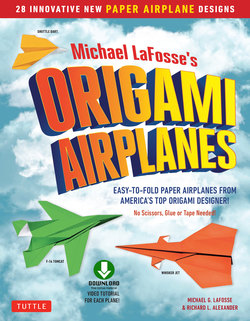Читать книгу Planes for Brains - Michael G. LaFosse - Страница 6
На сайте Литреса книга снята с продажи.
ОглавлениеA Passion for Origami Airplanes
By Richard Alexander
Unusual colors and papers make origami airships transcend the world of toys.
An eight-year old standing beside me peered into the glass showcase of LaFosse’s original paper airplane designs on display at the Peabody Essex Museum. The F-14 Tomcat in the case was being studied intently. An older friend walked up and authoritatively informed us that there was a paper fighter jet on the Internet that was even more awesome. I pointed to the legendary design in the case and said, “Michael LaFosse designed and folded that when your mother was in diapers!” They laughed, and I offered to show them how to fold one of the other LaFosse models in the case. We took a seat one of the tables, and within a couple of minutes, they were flight-testing their Shuttle Darts (see page 32) to great delight.
When I first met Michael LaFosse in 1988, I noticed several boxes stacked in a corner of his living room, and I asked, “What’s this?” Michael reached in and proudly presented me with his 1984 Aero-gami pamphlet, The F-14 TOMCAT: An Origami Model. Then he picked up a deep-blue, folded fighter jet from the table. This sleek F-14 was particularly amazing for its likeness to the nimble jet, with its twin stabilizers and perfectly proportioned and set wings. He gave it a snap and it shot across the room—fast, straight, and true. I had never seen such an elegant paper airplane design, and I was impressed that he designed and folded it from a single square without making any cuts or using any tape.
Some of us escape into books, music, or even crossword puzzles for relaxation. One of Michael’s favorite ways to relax is to immerse himself into what he calls “a blissful world of grappling with the triple-faceted challenge of designing a plane that looks elegant, is interesting to fold, and flies great.” After doing this for decades he has developed hundreds of designs spanning a wide variety of styles. His contributions to the present crop of popular paper airplane designs include innovative nose and fuselage locking features, as well as several other clever folding techniques that he has shared at workshops, conventions and contests for years. His inspiring, passionate teaching style has made an impact upon thousands of other paper airplane enthusiasts and designers around the world, most recently at the Red Bull Hangar-7 “Masters of Origami” exhibition and paper airplane workshop in Salzburg, Austria.
I was an early fan of Michael’s. As an environmental consultant, I had documented industrial projects with video since 1980, and one look at his F-14 Tomcat booklet made me think that video—rather than just folding diagrams—might be a better way to show how to fold it. Michael’s origami F-14 Tomcat was the first model we videotaped him folding. I mounted the camera over the workspace. In this way, Michael and the viewer would see the project in the same orientation on their tables. This also ensured that Michael’s verbal references to right, left, top or bottom would make perfect sense. In 1992 we self-published a video collection of his favorite designs, that we called “Planes for Brains.” It was a hit.
Michael LaFosse poses with his creations under the nose of a particularly fetching North American B-25J “Mitchell” at the Red Bull Hangar-7 “Masters of Origami” exhibition.
Then, in 1996, we were asked to develop a first-of-its-kind, beginner’s origami video kit for QVC—a popular cable TV shopping channel—and thousands of customers enjoyed folding one of Michael’s airplane designs from that set. The same year, we opened our Origamido Studio in the Boston area, and we taught an original LaFosse paper airplane to nearly every group of students that visited. Scouts, homeschoolers, and engineers from Boston’s high-tech firms kept coming back for more. Michael seemed to never run out of his own clever paper airplane designs to share with our customers. We held mini-contests by taking turns aligning our toes to the threshold at the hallway door, and sailing the freshly folded planes through the narrow corridor toward the lobby.
Through the years, Origamido Studio developed a whole series of video origami lessons (on DVD, cable TV, and on the Internet), and Tuttle Publishing has embraced origami video instruction by including our DVDs in our latest origami books and kits, including Money Origami, Trash Origami, and Story-gami. These have proved to be so effective and well-received that we now have several more books and kits with DVDs in development.
We also have a long history of holding paper airplane contests at local libraries and museums, such as the Peabody Essex Museum (PEM) in Salem, Massachusetts.
Our first contests began in the early 1990’s, and grew to attract hundreds of people for what became an annual family event. Some of the most recent winners (within the oldest age bracket—the “Adult” category) recalled having been winners in the early years of the event, when they were among the youngest contestants (in the “Age 7 and Younger” category).
We hope that your journey might also culminate in a day of fun at a paper airplane contest that you and your friends organize for a special cause or community need. When that smitten youngster comes up to admire (or even critique) a particular paper airplane design on display, we hope that this book and will help you join in the conversation and share your favorite folds with them!
Enjoy!
Richard Alexander, President
Origamido, Inc.
